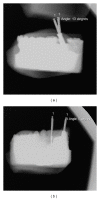Relative contribution of haptic technology to assessment and training in implantology
- PMID: 24701577
- PMCID: PMC3950590
- DOI: 10.1155/2014/413951
Relative contribution of haptic technology to assessment and training in implantology
Abstract
Background: The teaching of implant surgery, as in other medical disciplines, is currently undergoing a particular evolution.
Aim of the study: To assess the usefulness of haptic device, a simulator for learning and training to accomplish basic acts in implant surgery.
Materials and methods: A total of 60 people including 40 third-year dental students without knowledge in implantology (divided into 2 groups: 20 beginners and 20 experiencing a simulator training course) and 20 experienced practitioners (experience in implantology >15 implants) participated in this study. A basic exercise drill was proposed to the three groups to assess their gestural abilities.
Results: The results of the group training with the simulator tended to be significantly close to those of the experienced operators.
Conclusion: Haptic simulator brings a real benefit in training for implant surgery. Long-term benefit and more complex exercises should be evaluated.
Figures




Similar articles
-
Virtual aids and students' performance with haptic simulation in implantology.J Dent Educ. 2022 Aug;86(8):1015-1022. doi: 10.1002/jdd.12916. Epub 2022 Mar 11. J Dent Educ. 2022. PMID: 35275404 Clinical Trial.
-
Computer simulation as a component of catheter-based training.J Vasc Surg. 2004 Dec;40(6):1112-7. doi: 10.1016/j.jvs.2004.09.028. J Vasc Surg. 2004. PMID: 15622364
-
A patient-specific haptic drilling simulator based on virtual reality for dental implant surgery.Int J Comput Assist Radiol Surg. 2018 Nov;13(11):1861-1870. doi: 10.1007/s11548-018-1845-0. Epub 2018 Aug 10. Int J Comput Assist Radiol Surg. 2018. PMID: 30097957
-
What is going on in augmented reality simulation in laparoscopic surgery?Surg Endosc. 2009 Aug;23(8):1693-700. doi: 10.1007/s00464-008-0144-1. Epub 2008 Sep 24. Surg Endosc. 2009. PMID: 18813987 Free PMC article. Review.
-
Lessons from the surgical experience with simulators: incorporation into training and utilization in determining competency.Gastrointest Endosc Clin N Am. 2006 Jul;16(3):425-34. doi: 10.1016/j.giec.2006.03.009. Gastrointest Endosc Clin N Am. 2006. PMID: 16876715 Review.
Cited by
-
Distinguishing skill levels with haptic simulation in restorative dentistry: Myth or reality?Eur J Dent Educ. 2025 Aug;29(3):535-541. doi: 10.1111/eje.12939. Epub 2023 Aug 9. Eur J Dent Educ. 2025. PMID: 37559186 Free PMC article.
-
Findings Favor Haptics Feedback in Virtual Simulation Surgical Education: An Updated Systematic and Scoping Review.Surg Innov. 2024 Jun;31(3):331-341. doi: 10.1177/15533506241238263. Epub 2024 Mar 14. Surg Innov. 2024. PMID: 38486132 Free PMC article.
-
The use of virtual reality and haptics in the training of students in restorative dentistry procedures: a systematic review.Korean J Med Educ. 2025 Jun;37(2):203-217. doi: 10.3946/kjme.2025.335. Epub 2025 May 29. Korean J Med Educ. 2025. PMID: 40468496 Free PMC article.
-
The potential integration of Simodont® Dental Trainer in different stages of the dental curriculum.Saudi Dent J. 2024 Nov;36(11):1449-1455. doi: 10.1016/j.sdentj.2024.09.002. Epub 2024 Sep 3. Saudi Dent J. 2024. PMID: 39619714 Free PMC article.
-
The Current Situation and Future Prospects of Simulators in Dental Education.J Med Internet Res. 2021 Apr 8;23(4):e23635. doi: 10.2196/23635. J Med Internet Res. 2021. PMID: 33830059 Free PMC article. Review.
References
-
- Gallagher AG, Lederman AB, McGlade K, Satava RM, Smith CD. Discriminative validity of the minimally-invasive surgical trainer in virtual reality (MIST-VR) using criteria levels based on expert performance. Surgical Endoscopy. 2004;18(4):660–665. - PubMed
-
- Gallagher AG, Richie K, McClure N, McGuigan J. Objective psychomotor skills assessment of experienced, junior, and novice laparoscopists with virtual reality. World Journal of Surgery. 2001;25(11):1478–1483. - PubMed
-
- Gallagher K, Stephenson J, Brown RW, Holmes C, Ballester P. Exploiting 3D spatial sampling in inverse modeling of thermochronological data. Reviews in Mineralogy and Geochemistry. 2005;58(1):375–387.
-
- Okuda Y, Bryson EO, DeMaria S, Jr., et al. The utility of simulation in medical education: what is the evidence? Mount Sinai Journal of Medicine. 2009;76(4):330–343. - PubMed
Publication types
MeSH terms
LinkOut - more resources
Full Text Sources
Other Literature Sources
Research Materials

